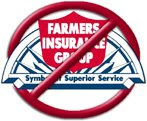Farmers Insurance to raise rates on homeowner policies
Farmers to raise rates on homeowner policies
By Laura Elder
The Daily News
Published March 19, 2008
Farmers Insurance intends to raise rates on a relatively new line of homeowner policies, a move that would increase premiums for some property owners in the county by 4.1 percent on average.
The planned increase comes as insurers, including Farmers, posted another profitable year of underwriting in Texas.
Effective May 16, Texas Farmers Insurance Co. will impose the increase on consumers who have a “Texas Family Home Policy,” which offers broader coverage than other Farmers’ lines and which the company introduced in Feb. 2006.
The amount of Farmers’ rate increase varies, but statewide the average is 7.9 percent, officials say.
The rate hike is meant to cover the insurer’s increased expenses caused by the rising cost of construction, reinsurance and growing loss trends, said David Bishop, a Farmers spokesman. Reinsurance allows insurers to buffer their risk by purchasing their own coverage against weather-related catastrophes.
The latest rate increase affects about 200,000 of Farmers’ 700,000 policyholders in the state who have coverage through the company’s Texas Family Home policies, Bishop said.
Two other subsidiaries of the insurer — Farmers Insurance Exchange and Fire Insurance Exchange — raised rates Feb. 1 resulting in average rate increases of between 14 percent and 16 percent for county residents.
Farmers has more than 10,700 policyholders in Galveston County. Farmers does not make available the number of county residents who have Texas Family Home policies.
Farmers also is raising rates to ensure financial stability and its ability to write new business, Bishop said.
He pointed to the freak thunderstorms and tornadoes that slammed parts of Georgia earlier this month, killing at least two people and causing an estimated $150 million in damage, according to reports.
“That could have been Texas,” Bishop said.
Insurers make money by underwriting and investing money they collect in premiums.
Underwriting in Texas was profitable last year, according to regulators at the Texas Department of Insurance.
Farmers, for example, posted a loss ratio of 38.7 percent.
The loss ratio is the amount of each premium dollar insurers pay back to policyholders in benefits. The lower the loss ratio, the better for the insurer.
The loss ratio does not include overhead expenses, which typically is another 30 percent to 35 percent, according to insurers.
In 2007, the industry in Texas reported earned premiums of nearly $4.9 billion and direct incurred losses of about $1.8 billion, resulting in a loss ratio of 36.5 percent, according to industry regulators.
Add in overhead expenses, and for each dollar of premium the industry collected in Texas, it paid out almost 71 cents, according to regulators.
Still, underwriting in Texas isn’t always profitable. The years 1992, 2001 and 2002, the industry collectively posted underwriting losses, according to state regulators.
While Farmers’ latest rate increase goes into effect in May, the insurer could have imposed them immediately upon submitting the plan to the state.
But most insurers try to give the state time to review the filings.
If the state deems the new premiums to be excessive, the company could be forced to offer refunds to consumers.
Farmers filed its intentions with the state to raise rates on Friday. Regulators still are reviewing Farmers’ filing.
The state did not oppose rate increases by Farmers Insurance Exchange and Fire Insurance Exchange.
+++
2007 Preliminary Loss Ratios
Here are the 2007 preliminary loss ratios for the top 10 insurers doing business in Texas. A loss ratio is derived from what insurers took in through premiums and what they paid out in claims.
For example, a loss ratio of 40 percent means that for every dollar collected in premiums, the company paid out 40 cents in claims.
The figures in this list do not include overhead expenses, which the industry and regulators say amount to another 30 percent to 35 percent.
Company, Direct Written Premium, Loss Ratio
State Farm Lloyds, $1.5 billion, 39.2 percent
Allstate Texas Lloyds, $630.07 million, 32.8 percent
Travelers Lloyds of Texas, $276.7 million, 25.2 percent
Texas Farmers Insurance Co., $250.05 million, 38.7 percent
USAA, $220.6 million, 40.7 percent
Farmers Insurance Exchange, $214.5 million, 33.7 percent
USAA Texas Lloyds, $171.1 million, 39.1 percent
Texas Farm Bureau Underwriters, $128.9 million, 46.6 percent
Chubb Lloyds, $117.1 million, 26.5 percent
Fire Insurance Exchange, $115.7 million, 42.4 percent
Source: Texas Department of Insurance
http://galvestondailynews.com/
http://www.star-telegram.com/
http://insurancenewsnet.com/
Labels: farmers insurance, texas



1 Comments:
My Farmers protector plus home insurance just went up 31% this year alone! I have all my insurance with Farmers, house, life, cars, motor home. With all these policies, I have only had one small claim of $700 some 10 years ago....we have not had any natural disasters here either!
Post a Comment
<< Home